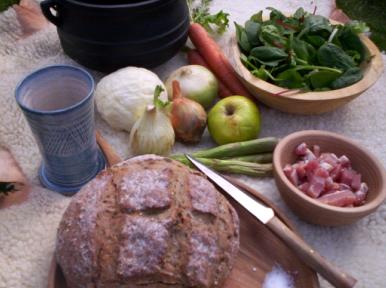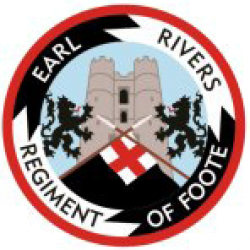When not on campaign soldiers were unlikely to have food in there snapsacks as fresh foods generally perished within the day. The Ration quantity was also lower for garrisoned troops as the supply of fresh food was generally more available with animals stored on the hoof and the availability of fresh foods i.e butter, eggs and fresh fish and vegetables that could have been obtained from the local market.
 Fresh Bread – Bread would have been issued in garrison, two examples of bread used during the 17th century especially during the English Civil Wars was manchet and cheat. Manchet was a fine bread and too costly for most men. Cheat bread is more like the Scottish sour bread, English household loaf, the normal soldiers loaf and the rye bread of the West Country Fresh Bread – Bread would have been issued in garrison, two examples of bread used during the 17th century especially during the English Civil Wars was manchet and cheat. Manchet was a fine bread and too costly for most men. Cheat bread is more like the Scottish sour bread, English household loaf, the normal soldiers loaf and the rye bread of the West Country |
 Fresh Meats – Meat was the main component of a meal in the 17th century and a wide variety of meat was eaten. Duck, Rabbit, Venison, Chicken, Game Birds and of course Songbirds like Larks. It was also a favourite trick to conceal all sorts of surprises in a pie in that period. 17th century pies look very similar to modern pies made from shortcrust pastry but they did not normally eat the pastry, It was simply a container to cook the meat in. Fresh Meats – Meat was the main component of a meal in the 17th century and a wide variety of meat was eaten. Duck, Rabbit, Venison, Chicken, Game Birds and of course Songbirds like Larks. It was also a favourite trick to conceal all sorts of surprises in a pie in that period. 17th century pies look very similar to modern pies made from shortcrust pastry but they did not normally eat the pastry, It was simply a container to cook the meat in. |
 Vegetables – A wide variety of vegetables were available to the common solider. They were often grown in farm and local cottage gardens. Vegetables – A wide variety of vegetables were available to the common solider. They were often grown in farm and local cottage gardens.
Vegetables that were most possible used; Cabbage, White or Red, Carrots (For reenacting look out for Purple carrots),Fennel,Leeks,Onions,Parsnip and turnips |
 Fish – The most easily carried was dried fish such as cod and hake, although it could be eaten pickled in salt barrels and fresh. Fish formed a significant part of most diets as Wednesdays, Fridays and Saturdays were normally fast days where meat was not eaten, so fish and dairy had to fill the gap. Fresh fish was more openly available to garrisoned troops. Fish – The most easily carried was dried fish such as cod and hake, although it could be eaten pickled in salt barrels and fresh. Fish formed a significant part of most diets as Wednesdays, Fridays and Saturdays were normally fast days where meat was not eaten, so fish and dairy had to fill the gap. Fresh fish was more openly available to garrisoned troops. |
 Dairy – Dairy produce was regularity available, milk was stored in barrel or large pots placed in the cooler out building or in the cellar so that it had a longer shelf life before it spoilt, milk was the main ingredient for butter and cheese production. Dairy – Dairy produce was regularity available, milk was stored in barrel or large pots placed in the cooler out building or in the cellar so that it had a longer shelf life before it spoilt, milk was the main ingredient for butter and cheese production.Butter was very commonly used in the lower society it could be used for cooking used as a source melted over vegetables and meats this enhanced the flavours it was also used as we today spread on bread. The price of cottage cheese, yargs, and brie was also in reach of the common solider. |
 Nuts, berries and herbs – The most common nuts were the chestnuts, hazel nuts, and walnuts. Walnuts would of been eaten green before the shell hardened. Herbs that were most possible used; Alexanders – horse parsley, wild parsley, Black pot herb Arrach, – used for cooking and salads, Mints, Parsley, Rosemary, Sage, Sorrel, Spinach, Savory, Tyme. Nuts, berries and herbs – The most common nuts were the chestnuts, hazel nuts, and walnuts. Walnuts would of been eaten green before the shell hardened. Herbs that were most possible used; Alexanders – horse parsley, wild parsley, Black pot herb Arrach, – used for cooking and salads, Mints, Parsley, Rosemary, Sage, Sorrel, Spinach, Savory, Tyme.Eexpensive (luxury) items would include spices (e.g., pepper, mace, cinnamon, nutmeg, ginger), almonds and sugar. |
 Mustard – Mustard was bought to the house in seed form, common mustard contained a yellowish seed and was sharp, hot and biting to the tongue. Mustard sauce was used as well to flavour dishes and although not issued it is believed that a soldier might carry a small quantity for flavouring. Mustard – Mustard was bought to the house in seed form, common mustard contained a yellowish seed and was sharp, hot and biting to the tongue. Mustard sauce was used as well to flavour dishes and although not issued it is believed that a soldier might carry a small quantity for flavouring. |

